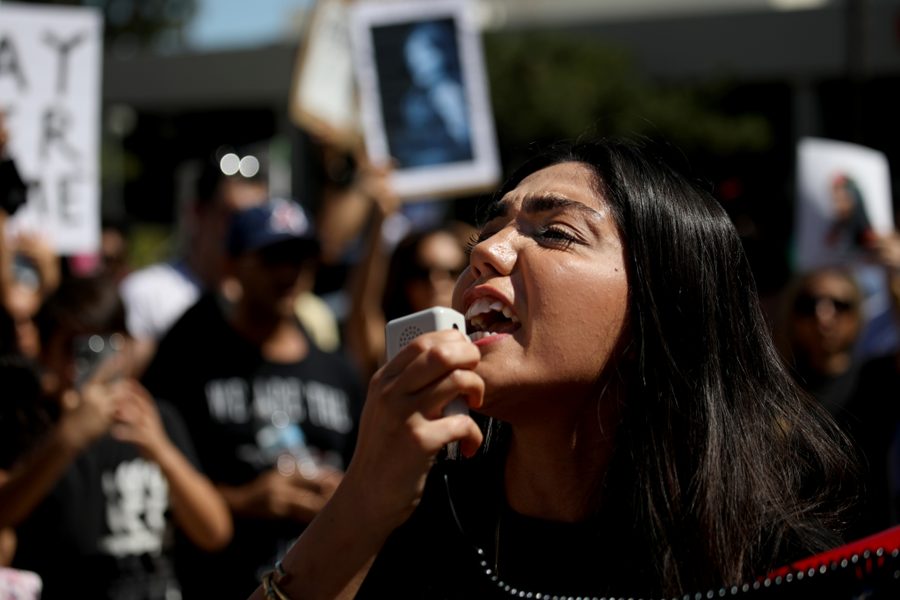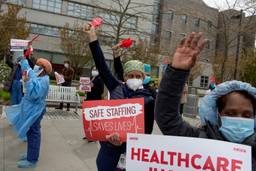Teachers and Other Unionists Are Joining Iran’s Gender Justice Uprising
As part of the nationwide protests in Iran, women union members are taking to the streets, saying: “we have nothing to lose but our lives.”
Alborz Ghandehari

The world is currently witnessing an uprising in Iran, in the face of great state brutality, for liberation from gender, social and economic oppression. This nationwide revolt, the latest in a series of popular uprisings, was sparked by the brutal killing two weeks ago of a young Kurdish-Iranian woman, Mahsa Zhina Amini, in custody of the state’s Guidance Patrol, or “morality police,” for so-called improper hijab (headscarf and coverings legally mandated in Iran for women).
Protesters have called for an end to the dictatorship, that the policing of women’s bodies be stopped, that hijab be optional according to each individual’s personal choice, an end to discrimination against Kurdish people and other ethnic minorities in Iran, and an end to economic injustice. Women and young people are at the forefront of these protests and students at numerous universities have boycotted classes. At least 83 protesters have been killed by security forces. What we are witnessing in Iran is a feminist revolt that has sparked a larger anti-government uprising.
The current uprising also helps illustrate the centrality of gender justice to working-class struggle. Last week, Kurdish shopkeepers launched a general strike across Iranian Kurdistan in protest of Zhina’s killing, and some workers and labor unionists across the country are taking action to support the uprising as well. In a statement this week, the Council of Contract Oil Workers said they “support the popular struggles against organized and daily violence against women and against poverty” and threatened to withhold their labor if the state does not end its “arrests, massacring of people, repression, and harassment and harm of women because of hijab.”
On September 25, the Coordination Council of teachers’ unions in Iran threw its weight behind the uprising and launched a two-day strike. The teachers, who have been engaged in a wave of strikes and protests since last December, wrote that the uprising shows “Iran is still alive and active, and does not bow down in the face of oppression.” The Council condemned the use of schools in the country as militarized bases to suppress protesters. They called on all working and retired teachers — as well as retirees in government, army, and social service sectors, workers’ unions, athletes and artists — to stand alongside “the rights-seeking people of Iran.” A coalition of women teachers on strike released their own statement declaring “our solidarity with other justice-seeking people and protesters to this crime for which there is no accountability and never will be.”
While on strike this week, teachers urged Iran’s broader labor movement to escalate the current uprising against the Iranian state to help secure gender justice, democratic freedoms and economic equality. As 60 percent of teachers in Iran are women, they have an important role to play in the current uprising. The leadership of the teachers’ unions is overwhelmingly male, but women teachers have increasingly formed core cadre in the recent strikes and protests. Many women leaders in the teachers’ movement have made demands in recent months that are key for the success of the current popular struggle, and show the intersection of working-class and gender struggles.
For example, these mostly rank-and-file leaders have demanded the transformation of educational content and textbooks to foreground gender equality. They have demanded the building of more schools in rural areas, noting that girls are less likely than boys to be sent to schools outside their village. They have demanded free education for all and an end to the privatization of Iran’s public education system, as a large majority of Iran’s public schools now collect fees from students. They have demanded a dignified wage above the poverty line for all teachers, and equal pay for men and women. They have joined countless freedom-seeking people in Iran in demanding the release of all political prisoners, whether labor, student, or women’s rights organizers. They have demanded sex education around issues of healthcare and sexual harassment, as well as contraception, which is significant given Iran’s 2021 population law which imposed increased restrictions on abortions and banned the distribution of free contraceptives by the healthcare system. They have demanded expanded maternity leave and daycare centers at the workplace. And they have demanded that school administrations stop harassing them for improper hijab. These calls from a segment of working-class Iranian women form an integral part of the broader Iranian feminist movement which has been thrust onto the global stage in recent weeks.
In many ways, the slogan of “Woman, Life, Freedom” that has swept the country’s streets in recent days goes hand in hand with the slogan of “Bread, Work, Freedom,” which emerged during previous nationwide uprisings in Iran against austerity and the high cost of living, both in late 2017 as well as in November 2019 when a gas price increase quickly led to anti-government protests. In November 2017, weeks before the uprising that year, five women workers in the militant Haft Tappeh Sugarcane Workers Union blocked off a road in protest of low and delayed wages, the privatization of their company and the hiring of workers on exploitative temporary contracts. Actions like these show the importance of leadership by women workers. These workers are part of a larger Iranian working class that has taken part in an uptick in strikes and labor militancy in recent years, from sectors as diverse as petrochemicals, trucking, and heavy equipment. These actions have come as a result of domestic and international crises in global capitalism, and the greed of both domestic and foreign elites.
The uprising in Iran must also be seen in an international context, as part of a larger global movement for gender equality across the world among women and trans, queer, and non-binary people who are facing different, yet interrelated types of attacks. Solidarity protests in countries such as Chile, Lebanon and Turkey have amplified the uprising in Iran and lent protesters morale.
Within this context, we have the opportunity to connect the fight in Iran to the current fight in the United States for reproductive justice. Some of the same U.S. political leaders, like Mike Pompeo and Donald Trump, who helped lead the crusade against Roe v. Wade and abortion rights have claimed to support women’s rights in Iran. But you cannot set back gender equality in one country and support it in another. And while U.S. politicians harm the cause of gender equality in the United States, they have also played a role in harming Iranian women. Both Democratic and Republican political leaders have imposed sanctions on Iran which have not weakened the oppressive Iranian regime or economic elite, who grow richer and more oligarchic in spite of sanctions. Rather, sanctions have exacerbated Iranians’ economic hardships, including straining Iranian women’s access to reproductive healthcare. U.S .foreign intervention has a terrible track record, including the 1953 CIA-led overthrow of the only secular democratic government Iran has ever had in its modern history. Today, rather than the hollow support of the United States and other Western governments, the protests of thousands of everyday people in countries across the world are amplifying Iran’s uprising for gender justice, forging connections between movements to lend them meaningful strength and longevity.
In March 1979, tens of thousands of women marched in Tehran against compulsory hijab and other policies which attacked women’s rights instituted by the new Islamic Republic which came to power after the Iranian Revolution that year. They believed, as today’s protesters do, that hijab should not be weaponized as a tool of repression by the state but should rather be a personal decision for women according to their beliefs. Those women revolutionaries chanted “We did not carry out the revolution in order to go backwards.” They wanted the world to remember that women helped power the 1979 revolution against the U.S.-backed dictatorship of the Shah — and for social and economic justice. Yet the replacement of the Shah’s regime with a new oppressive dictatorship, the Islamic Republic, meant that the struggle for freedom was derailed and would continue.
The protesters taking the streets today are risking their lives to make sure that it does. As striking women teachers said this week, “The rulers should fear the day we have nothing to lose but our lives, and that day has come, and until our pupils and imprisoned students and teachers are free we will not be in the classroom.”
Alborz Ghandehari is a Salt Lake City-based organizer, performance poet, and Assistant Professor of Ethnic Studies at the University of Utah. Some of his writings on Iranian and international social justice movements appear in Jadaliyya, Social Identities, and Critical Ethnic Studies Journal.




